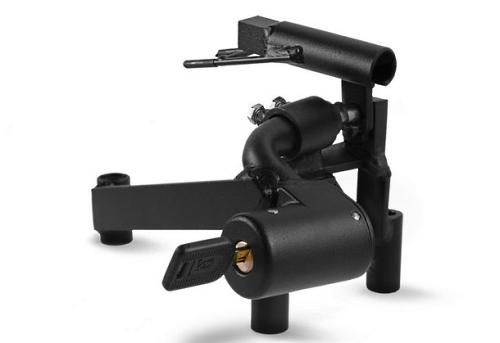
Mechanical anti-theft locks. Mechanical anti-theft devices: which ones are better to buy
Content
- What is a mechanical anti-theft system?
- Types of mechanical anti-theft systems
- How to choose a mechanical anti-theft system
- Installing a mechanical anti-theft system
- 1. Gearbox blocking device.
- 2. Lock the rudder.
- 3. Locking wheels.
- 4. Anti-theft ignition locks.
- 5. Locking the door.
- 6. Closing the hood.
- 7. Brake blocking device.
Remember, not so long ago in one of the articles we talked about immobilizers - an electronic device that prevents car theft? So today it will be all the same anti-theft systems, but not electronic, but mechanical.
From the previous point of view, they differ only in the way of opening the contacts (with a key and only from inside the car), i.e. disconnection from a distance is not possible. Therefore, many drivers consider mechanical systems to be more reliable than electronic systems, which block all systems in the car in the event of a network failure, and no one else goes anywhere without the help of specialists.
Of course, there are motorists who are skeptical about the mechanics, they say, attackers easily mount the device, but I must quickly reassure you - everything is not so simple. For all manufacturers of such anti-theft devices, complete with locks “intended for the herd”, the screws have a special cap, which splits during installation and it is impossible to unscrew the screw in the future. We will discuss the detailed operation of mechanical safety systems below.
What is a mechanical anti-theft system?
Mechanical anti-theft system - this is actually a mechanical gearbox and a steering mechanism in the form of pins, screws and other devices that interfere with their work. Such systems today are significantly different from their ancestors of the 90s (which were just a "ram" on the wheel). However, the history of anti-theft systems dates back to the time of the appearance of the first cars, and more precisely since 1886. Such a novelty in the transport world was available only to wealthy people, who often aroused envy the rest of the time. It is not surprising that many not very decent citizens simply dreamed of stealing a car.
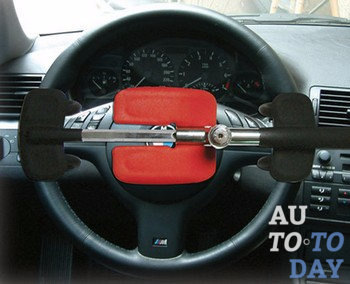
So for the first time, the question arose of how to protect the owners of their cars. Of course, there is no need to talk about all electronic means of protection at the end of the XNUMXth century, so the only option was to protect the car with mechanical devices from theft, some of them even "survived" to this day. Therefore, drivers used locks, plugs and other improvised items, such as steering column locks, door locks, the installation of which interfered with the operation of the vehicle and thereby protected it from theft.
Interesting fact! The first Peugeot car was stolen from a French baron in 1889 straight from his private garage.
The first mechanical anti-theft devices did not require special installation and were articulated. A little later, protection systems began to be built into cars directly at manufacturers' factories; it was also possible to supply such equipment in private workshops. An alternative possibility of mechanical security systems appeared only after the Second World War - electronic devices appeared in production.
Types of mechanical anti-theft systems
All existing mechanical anti-theft systems are divided into three types: they block various working bodies from the movement of the vehicle, which prevents its penetration into the machine. Devices for fastening the movement of a vehicle, in particular, include a blocking cardan shaft, which is installed on a rear-wheel drive or all-wheel drive vehicle and consists of a latch and power elements. The first is in the cab of the car, the second is under its bottom. The main function of such a lock is to prevent the rotation of the driveshaft, due to which the car stands still.
![]() Currently, these are conventional anti-theft systems designed to protect the vehicle interior by locking the cab doors, luggage compartment and hood. Usually this type of protection is installed at the factory and most often an electromagnetic protection system is used, in addition, mechanical elements can be installed. For example, in order to exclude the possibility of disabling the electronic security system using the connector under the hood of the car, it makes sense to additionally install a mechanical device that protects the hood. Such a device, in principle, is supplied with a cable in a flexible sheath that prevents breaking of a regular lock.
Currently, these are conventional anti-theft systems designed to protect the vehicle interior by locking the cab doors, luggage compartment and hood. Usually this type of protection is installed at the factory and most often an electromagnetic protection system is used, in addition, mechanical elements can be installed. For example, in order to exclude the possibility of disabling the electronic security system using the connector under the hood of the car, it makes sense to additionally install a mechanical device that protects the hood. Such a device, in principle, is supplied with a cable in a flexible sheath that prevents breaking of a regular lock.
Finally, the most popular mechanical anti-theft devices are devices that interfere with the operation of various working bodies. There are two main types of such devices: one is designed to lock the transmission, and the other is to lock the steering wheel and prevent it from turning. Both types are installed as standard or optionally.
To lock the gear lever, next to the gear lever, there is a hole in the interior of the car, into which a metal pin is inserted, which is equipped with a corresponding lock that would pull it out, this was only possible by using a key. This device is suitable for mechanical and automatic transmissions. If you have a mechanic, the pin will block all gears except the reverse, and the machine will not allow you to change the parking mode on the car and the car will not move. In addition to plugs, it is now possible to equip the machine with incomprehensible designs using built-in locking mechanisms. Such devices will not be able to move the lever (or block the gear selection), and the opening (closing) mechanism can only be a key, the lock is on the dashboard or between the front seats.
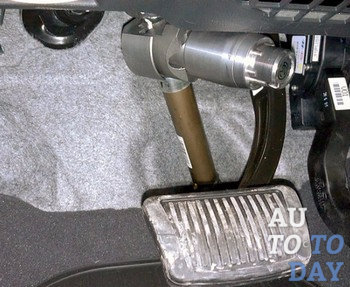 Almost all standard vehicles are equipped with steering column boxes. The principle of its operation is as follows: a mechanism connected to the ignition lock, in the absence of a key, prevents the steering wheel from turning and does not allow it to turn. True, there are pleasant serious flaws - lacks strength and in the event of a sharp turn, the locked steering wheel can break.
Almost all standard vehicles are equipped with steering column boxes. The principle of its operation is as follows: a mechanism connected to the ignition lock, in the absence of a key, prevents the steering wheel from turning and does not allow it to turn. True, there are pleasant serious flaws - lacks strength and in the event of a sharp turn, the locked steering wheel can break.
Many drivers use optional articulated steering lock systems. They are in the form of a clutch (attached to the steering wheel) with a corkscrew attached to it, which sits above the dashboard and limits steering rotation. The whole mechanism is equipped with a lock that opens with a key. Maybe some motorists think that such a design is not very reliable and the lock can be opened if desired, but believe me: this is quite problematic. It is rare that a hijacker, if he has noticed such protection, wants to kill himself with a vehicle, because you can find another that will be easier to steal. The positive psychological effect of using the rudder lock should also be noted.
Pedal boxes and "secrets" on the wheels of a car are less common. Its essence is the presence of a non-standard screw, which can only be unscrewed with a wrench of the right size, and this, of course, is only the owner. It should be noted that most mechanical anti-theft systems have a relatively simple design, but nevertheless, for many years in a row they have been fulfilling their main role in a quality manner - to protect cars from criminals.
How to choose a mechanical anti-theft system
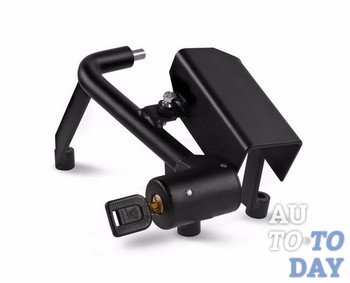
As you have noticed, today there are many types of automotive anti-theft systems of a mechanical type. All of them are quite diverse and start with a steering wheel block, which ends with a pedal lock. Once you have decided to equip your car with a mechanical protection system, you must first find out exactly what it will be installed: just lock the steering wheel, or maybe better, lock the transmission, and suddenly immediately immediately effectively save and prevent an intruder from even getting inside . car. But the last one is real. A reliable anti-theft system should consist of three parts:
- to deprive the thief of the opportunity to penetrate the device (blockers of doors, hood and fuselage);
Exclusion of the possibility of starting the car (non-standard blocking of chains, electromechanical blocking of the cover);
Don't let go (lock transmission, steering wheel, pedals)
Based on this, you will need to purchase all of the listed types of mechanical blocks. But if you decide to buy, for example, only a mechanical transmission lock, they should pay attention to such important points:
– should only work in conjunction with an alarm;
The lock on the gearbox must be made of solid metal, which will give it a certain resistance to vandalism and protect it from drilling and sawing;
It is better to pay attention to the universal transmission lock, which is suitable for different car brands and designs.
This type is one of the most reliable ways to protect your car's manual (not including built-in installation), and the choice of a specific lockout checkpoint depends on your car model and your budget.
In general, the choice of a specific mechanical anti-theft device should be based on your needs. For example, if the car will spend the night in a parking lot or under the windows of a house, in addition to an alarm, first of all, you should buy hood and steering shaft locks.
Installing a mechanical anti-theft system
Depending on the type of mechanical anti-theft system you have chosen, we differentiate between different installation steps. Let's consider the installation process for the most common ones: transmission lock и steering shaft.
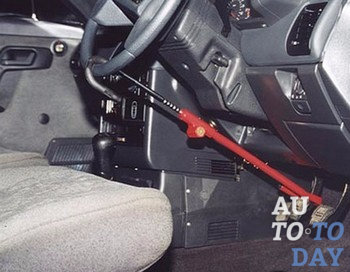
The mechanical interlock transmission is divided into universal и model. Lockers are more convenient for customizing the model than for customizing them individually for each car model, taking into account all the parts and assembly of the lock in order to avoid problems during the installation process. The set of devices contains instructions that are described in detail during the installation process, and due to the lack of the need to interfere with the design of the checkpoint, even a beginner can assemble motorists.
Universal cabinets are suitable for almost any vehicle, but are most often installed on older car models. In this case, you will need experience in this area and knowledge of all the intricacies of the control station mechanism. Unlike the installation of pins of previous types, it is advisable to entrust the installation to qualified specialists. The installation of the steering column assembly is often not so serious and involves the following steps:
– blocking of a wheel by means of the anticreeping device;
Mounting of the coupling parts on the steering shaft (if the orientation is correct, the fork can easily come out of the groove);
Unlocking the steering wheel and removing the plug;
The clamp of the clutch fastener must not interfere with the free rotation of the steering wheel;
Fastening the plastic holder to the driver's seat (a retainer is inserted into it when there is no need to block the steering shaft).
The installation of different types of locks in different models is not very similar to each other on a car and it is simply impossible to describe all of its shades in one article, and even given the complexity of the assembly process, it would be logical not to apply it to special service centers at all.
Subscribe to our channels
Mechanical protection against theft is the same - blockers are special devices that block certain places, and automotive parts, the main task of which is to prevent unauthorized entry into the vehicle, its control and movement.
They can be very different: removable and stationary; universally or strictly adapted for a specific model and car brand; act as an integral part of the entire security complex or a separate means of protection. However, most often blockers are divided according to the types of devices they block. Let's take this classification into account. By the way, I already wrote about anti-theft systems earlier.
1. Gearbox blocking device.
The most common mechanical anti-theft device for cars and is relatively effective. They can be external and internal.
The external lock works as follows: the gear lever is in a certain position, usually reversible, and is fixed (stationary) in it. In this case, the locking device itself can have both a simple and a complex shape, be it a pin or an arc.

Internal blocking requires intervention directly into the gearshift mechanism itself, so it is not visible in the cabin. Hidden under the cover of the central tunnel device, it creates only the locking cylinder located on the gear lever. The principle of operation of the internal blocker is similar to the principle of external blocking, only the blocking occurs in different ways.
The main disadvantage of these mechanical devices is that they do not preclude the possibility of towing the vehicle in which they are mounted using a compressed clutch. An exception is cars with an automatic transmission, in which the lever of the last belt is moved to the "parking" position.
Their advantages:
- high resistance to theft (when installed by specialists, the blocker must be internal).
2. Lock the rudder.
The principle of operation of this device is that the steering wheel is fixed in one position and rotates in this way - and you can change the trajectory of the car even when the engine is running. The same immobilizer on the steering wheel is attached to the steering wheel or to the steering wheel and to one of the pedals of the car.
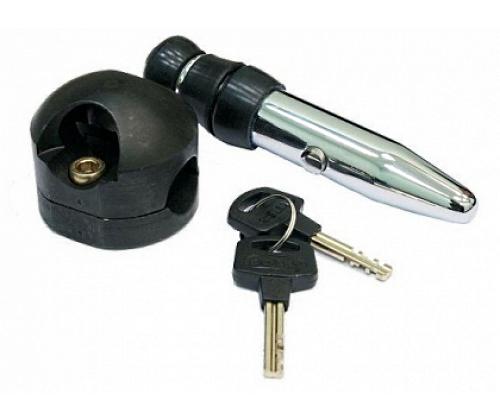
The advantages of these mechanical devices:
- budgetary.
limitations:
- low degree of car theft protection.
It is most reasonable to use the steering wheel lock in crowded places only during daylight hours and on condition that you leave soon.
3. Locking wheels.
It is a structure made of solid steel, with which the wheels are fixed from movement. This device is very reliable, since it can only be removed using a special tool (cutter, grinder), although it is not very popular with car owners, since it has too many shortcomings.
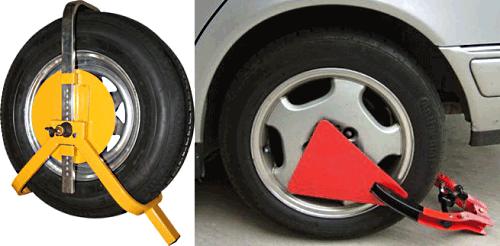
Disadvantages of wheel locking:
- bulky;
- unattractive appearance;
- the need for regular cleaning and pollution, which causes special problems in bad weather.
advantages:
- maximum efficiency (but only if there is a wheel rollback protection device in the device against replacing a wheel with a spare wheel);
- independence from automotive electronics.
4. Anti-theft ignition locks.
An excellent alternative to conventional ignition locks, combining the functions of this device, the anti-theft lock function, a number of service functions and starter protection.
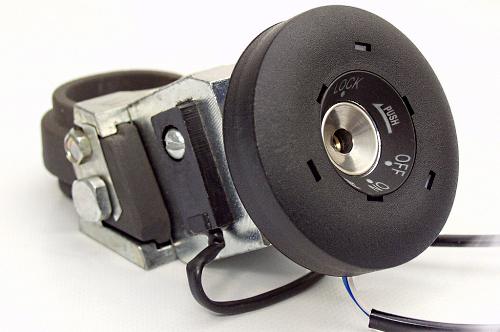
Advantages of anti-theft ignition locks:
- a decent degree of protection against key selection, master key opening;
- high classification - more than 1 billion combinations.
limitations:
- require replacement of the standard ignition switch.
5. Locking the door.
Looks like another hidden latch in conventional mechanical door locks. Usually they are protected against opening with a metal ruler (master key).
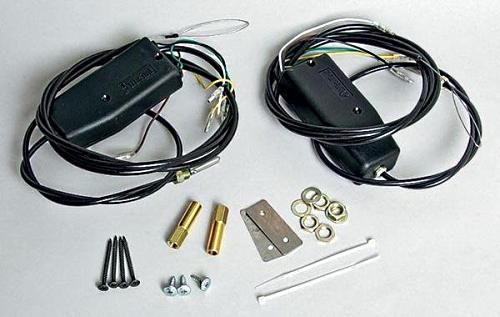
limitations:
- will not protect you from entering the car through broken glass;
- high installation costs, as this means protecting all vehicle doors.
6. Closing the hood.
This device looks like a very strong cable, which is equipped with a locking device, which for greater safety it is better to see from the inside, rather than go outside. As an independent means of protection, this mechanical anti-theft device is ineffective.
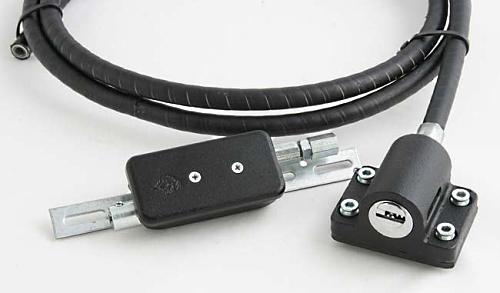
There are two types of hood locks:
1. Mechanical.
The mechanical hood lock has a classic locking device with a cylinder key. The advantages of such a device are its simplicity and reliability, as well as its electronic independence (the presence of current in the electrical circuit does not affect its efficiency). Disadvantages: minor installation problems; it is possible to open a lock pick, drill, etc.
2. Electromechanical.
The structure of such a device includes: locking mechanisms, power lines and an electric drive and control by signals from electronic devices: alarm, immobilizer, digital relay. The first option is the most common.
Advantages of electromechanical hood locks:
- simplicity of installation;
- easy to use.
limitations:
- communication with alarm;
- depending on the wiring diagram of the vehicle (with a discharged battery, this locking device cannot be opened).
7. Brake blocking device.
It looks like a small block with a check valve that penetrates the brake circuit (one or two). This device is turned on and off mechanically (using a key), the security of the lock determines the reliability of the lock. Its main task is to protect the car from theft.
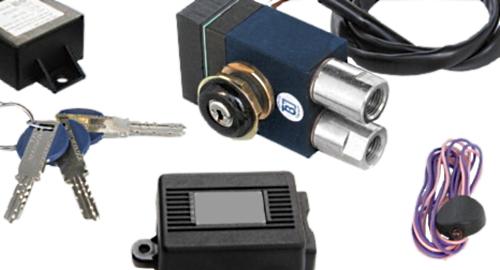
Disadvantages of the evaluated mechanical equipment:
- high costs;
- the need for intervention in the brake system.
advantages:
- The neutralization of the shut-off device can only be switched off via the brake hose, with the unlikely risk that anyone will do this.
Just a reminder. I just write my own opinion 🙂 I do not pretend to be complete. The challenge is easy to understand, for everyone.
Sort it out one by one.
1. The employee locks the steering wheel. Done. the pin that "protrudes" when the ignition key is removed. In fact, this is nothing. Breaks off when kicked on the steering wheel.
2. Poker on the steering wheel, “lock” on the pedal. In fact, this is nothing. , The steering wheel is bent or easy to eat. because the steering wheel is not very rough rim. The pedals just bend. You can remove it completely.
3. Locking device at the test point , with or without pin with internal pin. In fact, this is nothing. Gear Lever - Moves one or two cables. These cables are placed in a box and moved according to the switches. Even if you lock the lever, it is quite simple - remove the links from the lever or selector. Move the selector manually. Usually it is enough to go to the cleaning or to the neighboring yard. And there is something to understand ...
4. Locking device on the steering shaft , enter Guarantor. A clutch is connected to the steering shaft. Which constantly rotates along with the shaft. There are guides on the cuffs. A metal wedge is inserted “by touch” into these guides, which is attached to the coupling. This blocks the steering shaft. To remove the pin, you must also insert the key into the larva on the pin, touching it.
Both manipulations are quite annoying. You will gradually get used to it. Girls are usually uncomfortable. Remove by theft - enough gimoroyno. I recommend enhancing the anti-theft properties of vehicles., available for privacy. installation. Recommendations: 1. when installing - rough skin - "jam" the surface on the steering shaft - for good fixation. 2. Leave the vehicle by turning the wheels to the side to block them. If the clutch is not tightened enough, the clutch can "slide" on the shaft. We need to secure a good landing.
5. Closing the hood. With fur. drive or electric drive.
The hood cover itself does not protect against theft. Improves signal properties. after all, usually at least one “lock” of the engine is hidden under the hood.
5.1 Leather fixation of the hood. Inside there will be a larva and a key to unlock. Usually - this is how the normal hood lock is blocked. Spom. ext. cable - the lock rail is closed with a hood. And without a key - pulling out the usual lever and opening the lid will not work. In practice, it quickly blows into the joints. He stretches. This option is not recommended.
5.2 The hood lock is electrically operated. It has a nominal name. Delete time. This is a mansion - "electric propeller". The hood is metal. loop or ball. And in the return part - a pin that moves along the cable, moves back and forth by an electric motor. Disk - Usually connected to a signal. When disarmed, the hood is unlocked. When the security is on, the hood is locked.
The logic is that if - without removing the cover, pull the hood lever, then the hood will not open (under the hood - under the hood the siren will quickly break, which will not work, - the electronic engine lock on which - is locked. together with the hood.
I recommend installing together, but with the conditions for a “correct” installation:
There are several important points.
1. If the signal is “opened” by electronic interference, then a “normal” connection opens - the cover is naturally -.
2. Normally, if you pull the hood lever when the protection time is locked, the hood will open slightly. You can see the pin.
3. Since the "screw" is at the front, dirt gradually clogs up and can become acidic. Regular WD40 lubrication is required.
4. If the battery is inserted, the cover remains locked. It will be difficult to open up without special skills. It is necessary to have a safety cable, which is hidden in the cab during normal installation. Pull out - you can mechanically - open the lock.
For a good implementation of protection, it would be nice to install Defanteim with the following track. moments:
1. Install two locks in the corners of the hood.
2. Spill protection (metal shaft, tube with pin).
3. Connect for example. DOES NOT OPEN when the key lock is off. When the ignition is turned on and the secondary immobilizer tag is marked, the locks are open. Gradual protection. So we will protect ourselves from the theft of keys in Auchan. But on condition that the immobilizer brand is carried separately from the keys.
4. Seat belts - do not remove in the car. Buy sale. wires to open the lock when the battery wears out.
6. Computer Armor , in addition to jokes 🙂 Blocks are often stolen because of their high cost. This is the metal floor of the case that covers the ECU and is attached to the case with switch screws. If you block the chip on the block, you will not be able to use the "spider" - another set of cables to run during thefts. The thing is quite exotic.
7. Girlok (Locking mechanism). Effective lock. “Defentaym also like it” Pin Power “Only the hood does not overlap. Recommended How defentaim - a lot depends on the signal. If the signal is triggered and easily opened by the “electronic sensor”, it can eliminate all efforts.
8. For the domestic auto industry - can be replaced steering lock -state of polio. It perfectly replaces the control unit “Garant”), while the larva also changes. It is not used for foreign cars, which is a pity.
